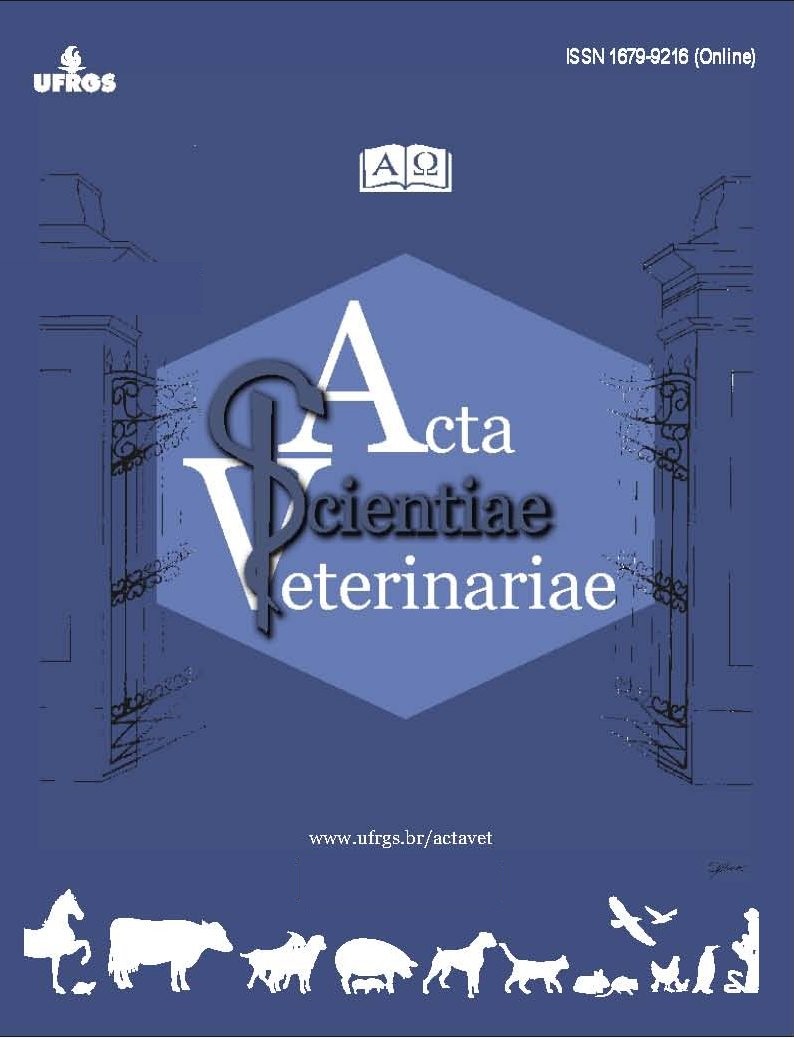Pneumothorax Secundaryto Accidental Electric Shockto a Dog
DOI:
https://doi.org/10.22456/1679-9216.140115Palavras-chave:
choque elétrico, injúria elétrica, pneumotórax, toracocentese, cãoResumo
Background: Pneumothoraxischaracterizedbytheaccumulationofairorgas in the pleural space. It isclassified as spontaneous, whichcanbeprimaryorsecondary, andacquired, whichcanoccurtraumaticallyoriatrogenically. Furthermore, it canbedefinedas openorclosedandhypertensiveorsimple. The clinicalmanifestationsinvolvedmainly include hypoxia, dyspneaandrespiratoryeffort, whichvarydependingonthedegreeofseverityofthepneumothorax, in additiontovomiting, anorexia andlethargy.
In more serious cases, immediateinterventionisrecommendedbydrainingfreeairintothethoraciccavitytostabilizethepatient, especially in theeventoftensionpneumothorax. Radiographyiscommonlyusedboth for thediagnosisofpneumothoraxand for follow-up afterdrainage, beinganeffective tool for evaluatingpossiblecontinuousleaks, in additiontoeliminatingunderlyinglungdiseases. Electric shockresultsfromthecontactofthe animal orpersonwith a sourceofenergy, in whichtheelectricityisconductedthroughthebodyandcan cause a series of injuries. The damageisdependentonthecurrent, voltage, heatgeneratedandthedurationoftheelectricalflow. Earlydiagnosis, followedbycorrectclinicaltreatment, increasesthepatient'srecoveryandsurvivalexpectations. Episodesinvolvingelectricshock in animalshavebeenreported in primates, in cattleand in dogs, while its associationwithpneumothoraxhasonlybeenreported in humans, with no reportsfound in theveterinaryliteratureregardingthisoccurrence in dogs. The presentreportaimstodescribethediagnosisandtreatmentof a case ofclosedpneumothoraxsecondarytoelectricshock in a dog.
Case: A two-year-oldfemaleGreyhounddogwastreatedatthe Santa Maria Veterinary Hospital, presentingdyspnea, anorexia, involuntarymusclecontractures, reportsofanepisodeofvomitingand a historyofanaccident in anelectricfenceapproximatelyone hour beforetheappointment. Onclinicalexamination, therectaltemperaturewas 39.1° C, tachypneic, 50 breaths per minute, 220 heartbeats per minute, andcardiacauscultationwasmuffled, andrespiratorysoundswerereduced, digital digitpercussiononboththoracicsideswith a muffledsound. 100% oxygentherapywasadopted via face mask, thoracentesis in theeighth intercostal spaceandcomplementaryimagingtestswerecarried out, such as radiography in twolaterolateralandventrodorsalprojections, bloodcollection for bloodcountandbiochemistry. In theanamnesis, the tutor reportedthatthepatientwasrunning in a cattlebreedingarea, wherehe came intocontactwiththelefthemithoraxregionon a fence, which, as confirmedbytheowner, wasenergizedwith a voltageof 11000 volts and 5 milliamps. Then, clinicaltreatmentwasinstituted, withcontinuedoxygentherapy, electrolytereplacement via intravenousRinger'slactate (5 ml/kg/hour), analgesia withmorphine 0.5 mg/kg, subcutaneously, andafterperformingtrichotomy for thoracentesis in theeighth intercostal space, in themost dorsal region, onbothantimeres, with a 21G scalpneedle, coupledto a three-wayvalveand a 20 ml syringeontherightandleftside.
Discussion:Thatthepatientrecoveredwithcertaintyfromtheelectricalaccidentaftertheapprovedclinicaltreatment.Theadoptionofemergency management appropriatetothe case, as well as anaccurateanamnesis, adequateclinicalandradiographicexamination, andtheimplementationofemergency procedures, such as thoracentesis, directlyinfluencedthesuccessfulresolutionofthereported case.
Downloads
Referências
Bhoite R., Preethi K., Chanakya T., Karunya G. & Muralidhar D. 2021. Traumatic pneumothorax in golden retriever dog: A case report. Journal of Entomology and Zoology Studies. 9(2): 690-692. DOI: 10.22271/j.ento.2021.v9.i2j.8550.3 DOI: https://doi.org/10.22271/j.ento.2021.v9.i2j.8550
Gilday C., Odunayo A. & Hespel A.M. 2021. Spontaneous Pneumothorax: Pathophysiology, Clinical Presentation and Diagnosis. Topics in Companion Animal Medicine. 45: 100563. DOI: 10.1016/j.tcam.2021.100563. DOI: https://doi.org/10.1016/j.tcam.2021.100563
Handa A., Tendolkar M.S., Singh S. & Gupta P.N. 2019. Electrical injury: an unusual cause of pneumothorax and a review of literature. BMJ Case Reports. 12(8): e230590. DOI: 10.1136/bcr-2019-230590. DOI: https://doi.org/10.1136/bcr-2019-230590
Singh D.K., Pandey G., Rizvi S.H.M. & Singh P. K. 2023. Isolated Pulmonary Hemorrhage After Electric Shock: A Rare Phenomenon. Monaldi Archives for Chest Disease. 94(1): 2518. DOI: 10.4081/monaldi.2023.2518. DOI: https://doi.org/10.4081/monaldi.2023.2518
Singh R. 2020. Electrocution in a Pup: a case report. Indian Journal of Veterinary Medicine. 40(2): 53-56.
Singh R., Choudhary N.S., Mehta H.K., Patil A.K., Kaur A. & Sabbineni H. 2018. Electrocution Management in a Monkey: A Case Report. International Journal of Animal and Veterinary Sciences. 5: 48-40.
Schulze C., Peters M., Baumgärtner W. & Wohlsein P. 2016. Electrical Injuries in Animals: Causes, Pathogenesis, and Morphological Findings. Veterinary Pathology. 53(5): 1018-1029. DOI:10.1177/0300985816643371. DOI: https://doi.org/10.1177/0300985816643371
Thrall D.E. 2018. Canine and Feline Pleural Space. In: Textbook of Veterinary Diagnostic Radiology. London: Elsevier, pp.670-683. DOI: 10.1016/B978-0-323-48247-9.00046-2. DOI: https://doi.org/10.1016/B978-0-323-48247-9.00046-2
Tufani N.A., Singh J.L. & Bhagat L. 2015. Therapeutic Management of Electrocution in A Rhesus Monkey. Journal of Wild life Research. 3(3): 27-29.
Yamamoto E.Y., Lavans L., Chaves R.N., Fragata F.S. & Santos M.M. 2009. Pulmonary Edema Secondary to Electrocution in Dogs - Case Report. In: Proceedings of 9th the World Small Animal Veterinary Association World Congress Proceedings. (São Paulo, Brazil).
Yogeshpriya S., Saravanan M., Selvaraj P., Sindhu R., Venkatesan M., Ramkumar P.K. & Premalatha N. 2022. Rare survival of high-tension electrocution shock in a crossbred Jersey cattle: a complete profile on critical care monitoring. Iranian Journal of Veterinary Research. 23(4): 385-389. DOI: 10.22099/IJVR.2022.43453.6356.
Arquivos adicionais
Publicado
Como Citar
Edição
Seção
Licença
Copyright (c) 2024 Fabiano da Silva Flores, Anna Vitória Hörbe, Marjane Maciel Correa, Bruna Borges Vaz, Luís Felipe Dutra Corrëa

Este trabalho está licenciado sob uma licença Creative Commons Attribution 4.0 International License.
This journal provides open access to all of its content on the principle that making research freely available to the public supports a greater global exchange of knowledge. Such access is associated with increased readership and increased citation of an author's work. For more information on this approach, see the Public Knowledge Project and Directory of Open Access Journals.
We define open access journals as journals that use a funding model that does not charge readers or their institutions for access. From the BOAI definition of "open access" we take the right of users to "read, download, copy, distribute, print, search, or link to the full texts of these articles" as mandatory for a journal to be included in the directory.
La Red y Portal Iberoamericano de Revistas Científicas de Veterinaria de Libre Acceso reúne a las principales publicaciones científicas editadas en España, Portugal, Latino América y otros países del ámbito latino





